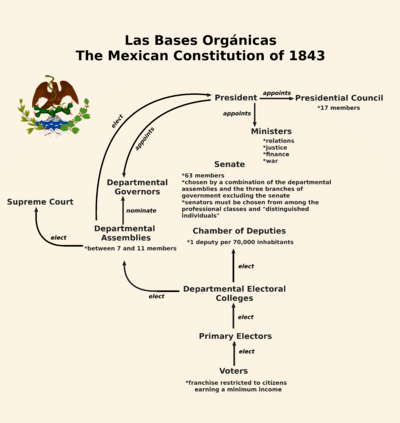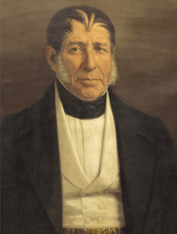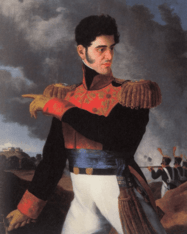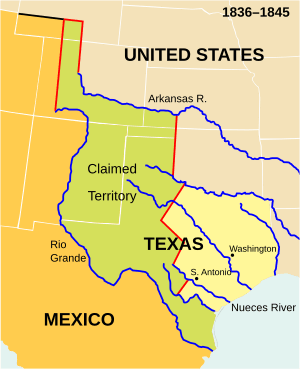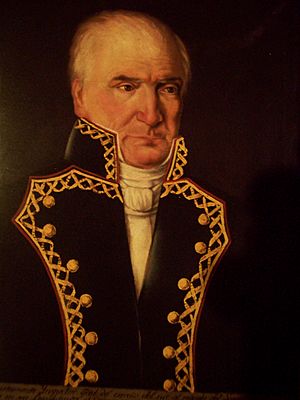Mariano Paredes (President of Mexico) facts for kids
Quick facts for kids
Mariano Paredes
|
|
|---|---|
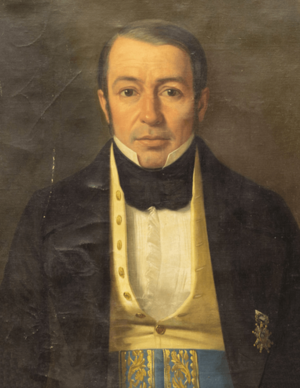 |
|
| 15th President of Mexico | |
| In office 31 December 1845 – 28 July 1846 |
|
| Vice President | Nicolás Bravo |
| Preceded by | José Joaquín de Herrera |
| Succeeded by | Nicolás Bravo |
| Personal details | |
| Born | c. 7 January 1797 Mexico City, Viceroyalty of New Spain |
| Died | 7 September 1849 (Age 72) Mexico City, Mexico |
| Nationality | Mexican Spanish (prior to 1821) |
| Political party | Conservative |
| Spouse | Josefa Cortés |
Mariano Paredes y Arrillaga (born around January 7, 1797 – died September 7, 1849) was a Mexican general. He belonged to the Conservative Party. He served as the president of Mexico from December 1845 to July 1846. He became president after leading a coup (a sudden takeover of the government) against the previous leader, José Joaquín de Herrera.
Paredes was known for leading several successful coups against the Mexican government. For example, in 1842, he helped overthrow President Anastasio Bustamante due to money problems. This led to a new constitution called the Bases Orgánicas. In 1844, he led another uprising against Antonio López de Santa Anna. Then, in 1845, he took power from President Herrera because Herrera wanted to recognize Texas as independent.
During his time as president, the Mexican–American War began in April 1846. Paredes had thought about making Mexico a monarchy (a country ruled by a king or queen). However, he focused on the war instead. After Mexico suffered many defeats, Paredes resigned in July 1846. Historians say he believed Mexico needed a strong military government. He thought this would work best with the help of educated and wealthy people.
Contents
Early Life and Military Career
Mariano Paredes y Arrillaga was born in Mexico in 1797. He started his military career on January 6, 1812. This was during the Mexican War of Independence. At first, he fought for Spain. He was promoted to second lieutenant in 1816. By 1818, he joined a company of grenadiers (special soldiers).
In March 1821, his regiment switched sides. They joined Agustín de Iturbide's Plan of Iguala. This plan aimed for Mexico's independence. Paredes fought in battles before the Trigarantine Army entered Mexico City. Iturbide promoted him to captain at Acámbaro. He also helped hold off Spanish forces at Arroyo Hondo. For his bravery, Iturbide gave Paredes a special coat of arms. He was also part of capturing Querétaro and Mexico City. For these actions, he became a lieutenant colonel.
After Mexico gained independence, Paredes continued to serve in the military. He became a general in 1831.
Paredes Enters Politics
Paredes became involved in politics around 1835. At this time, Mexico's first republic was falling apart. Antonio López de Santa Anna had led a coup. Mexico was changing from a federal republic to a Centralist Republic of Mexico. This new system was based on a constitution called the Siete Leyes. Paredes supported this centralist movement. He helped capture Zacatecas from federalist forces.
In August 1841, Paredes became a division general. He was also named commander general of Jalisco. Around the same time, President Anastasio Bustamante was struggling with Mexico's problems. Paredes called for a new government. He gathered troops and marched to Tacubaya. There, Santa Anna joined him. They formed a military group that created the Bases of Tacubaya. This plan completely changed the government. It also called for elections to create a new constitution. Santa Anna then became the temporary leader.
Even though Paredes played a big part in this change, he wasn't given a political job. He was sent back to Jalisco. Still, he remained loyal to Santa Anna. The new congress that was elected wanted a federal system. Paredes supported a plan to close this congress. On January 6, 1843, a group of centralists was chosen to write a new constitution. This group created the Bases Orgánicas on June 12, 1843.
Overthrowing Santa Anna in 1844
Paredes was invited to join a special group by Santa Anna. However, he left to become the commandant general of the State of Mexico. He started speaking out against the government. Paredes was arrested but later found innocent. The government tried to send him away to Yucatán to keep him from causing trouble. Paredes refused and was sent to Toluca. He felt frustrated and unappreciated, especially after helping set up the government. He became a senator but resigned after only a month.
At this time, there were growing problems with the United States over Texas. The government also forced people to give loans, which made many unhappy. Paredes began to think about leading another revolution.
The government knew Paredes was still a threat. They ordered him to go to Sonora. But when he reached Guadalajara, he spoke out against the government. The northern parts of Mexico joined him. Santa Anna still had enough support to plan a counterattack.
The president at this time was Valentin Canalizo, who was influenced by Santa Anna. Congress criticized Santa Anna for taking military command without their permission. They also blamed ministers for allowing Santa Anna to imprison the assembly of Querétaro. The government responded by closing congress. They said these actions were needed because the U.S. might take Texas. This led to a military uprising in the capital against Canalizo. He resigned, and on December 6, 1844, congress was brought back. Jose Joaquin Herrera became the new president. Mexico was now split between Herrera's government, Santa Anna's forces, and Paredes' uprising.
Santa Anna had 14,000 men and was on his way to crush Paredes. He declared himself the rightful president. He tried to attack Mexico City, but it was too well-defended. He then moved to Puebla, which fought back strongly. Meanwhile, Santa Anna learned that Paredes and Herrera had joined forces. Their armies were now about equal in size. Santa Anna tried to negotiate, but Herrera demanded his surrender. Santa Anna then tried to flee but was arrested.
Once again, Paredes had led a successful revolution but didn't become president. He was sent to a post in the north. However, he found a new reason to oppose the government. Herrera was trying to negotiate with the United States about Texas. Herrera considered recognizing Texas's independence if it wasn't annexed by the U.S. Paredes and his supporters saw this as giving away Mexican land. Paredes moved his forces to Celaya. He claimed he was just watching over travelers. But from there, he declared that the government was giving away national territory and dishonoring Mexico.
Paredes Becomes President
Paredes officially called for the government's overthrow on December 14, 1845, in San Luis Potosí City. He praised the old Spanish rule and criticized the republic. He promised that his would be the last revolution and that he didn't seek power for himself. He said a National Assembly would be formed with people from all parts of society. His plan was supported in San Luis Potosí and other parts of the country. The Herrera government had very little support. President Herrera gave up and resigned on December 30, 1845. Paredes and his forces entered the capital three days later.
On January 3, Mariano Paredes finally became president. He formed a new government. He passed laws against robbers and worked to reduce the number of government jobs.
On January 26, 1846, a special congress was called. This congress could make changes to the constitution. It was designed to represent different groups of people. It would have 160 members. These members would represent nine classes: landowners, merchants, miners, manufacturers, writers, judges, public workers, clergy (church leaders), and the army. Each class would elect its own representatives.
Ideas for a Monarchy
Paredes' plan for a new government allowed the congress to make any changes it wanted. Many people thought this meant they could get rid of the republic and create a monarchy. Paredes had expressed ideas about a monarchy since 1832. He believed only a monarchy could prevent chaos and protect Mexico from the United States.
With Paredes as president, people who wanted a monarchy saw their chance. Before the new congress met, there was a big debate. Newspapers like El Tiempo, run by conservative thinker Lucas Alamán, supported a monarchy.
In response, many Liberal Party newspapers changed their names to show they supported a republic. El Monitor Constitucional became El Monitor Republicano. El Siglo XIX became El Republicano. Carlos Maria Bustamante even published a newsletter called Mexico no quiere rey y menos a un extranjero (Mexico doesn't want a king, especially not a foreign one).
The idea that Paredes was trying to set up a monarchy caused strong opposition. This happened just as war with the United States was about to begin. On April 24, after the American invasion had started, Paredes said he supported the republic. He stated he would do so until the nation decided on a change.
Mexican–American War and Resignation

In the first few months of the Mexican–American War, Paredes' government faced many defeats. U.S. troops led by Zachary Taylor crossed the Rio Grande. They won several battles and reached Saltillo. At the same time, American forces were taking control of California.
The special congress met on June 6. Paredes appeared before them and promised to be loyal to the republic. Six days later, the congress confirmed Paredes as president. They chose Nicolás Bravo as vice president. Bravo was given command of Mexico's army in the war against the United States. The government was given special powers to find money for the war.
The war's progress made people even more angry with the government. Facing another revolution, Paredes resigned on July 28. He chose to return to the military to help with the war effort.
On August 3, the military in Veracruz revolted. They supported a plan from Guadalajara. During this uprising, Paredes was captured and imprisoned. President Bravo was also removed from power. Mariano Salas became the temporary president. On August 22, he brought back the Federal System. This was the same system Paredes had helped overthrow eleven years earlier.
Paredes was sent away to France on October 2, 1846. He returned before the war ended but did not fight in it. He lived in Tulancingo. He was asked to serve in the government again but declined due to his health. In April 1849, he was cleared of all past charges. He died in September of that year.
See also
 In Spanish: Mariano Paredes y Arrillaga para niños
In Spanish: Mariano Paredes y Arrillaga para niños


